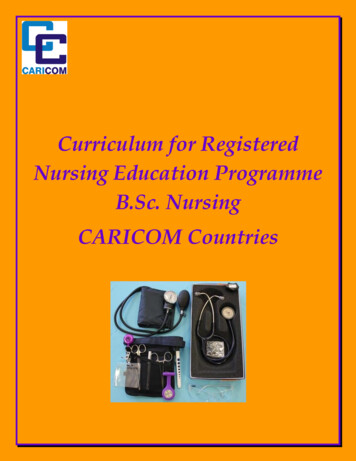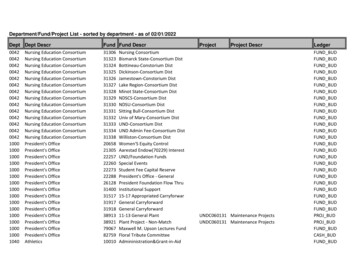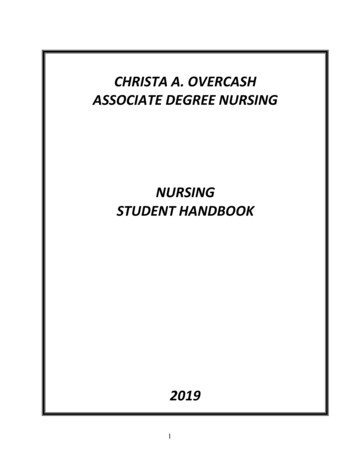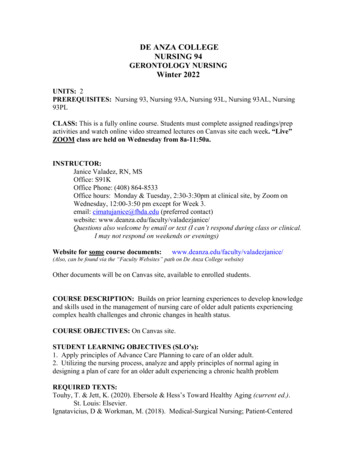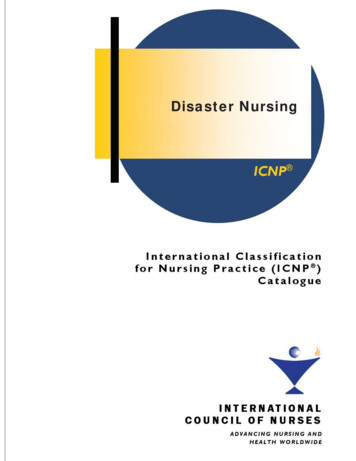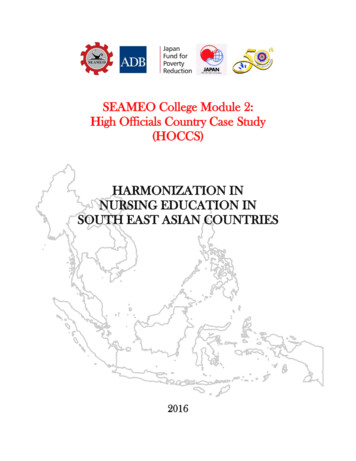
Transcription
SEAMEO College Module 2:High Officials Country Case Study(HOCCS)HARMONIZATION INNURSING EDUCATION INSOUTH EAST ASIAN COUNTRIES2016
SEAMEO College Module 2:High Officials Country Case Study(HOCCS)(R-CDTA 8389: Support for a Regional Platform on Innovations inEducation and Human Resource Development towards an IntegratedASEAN Community)HARMONIZATION INNURSING EDUCATION INSOUTH EAST ASIAN COUNTRIES
1ACKNOWLEDGEMENTSSEAMEO TROPMED Network would like to thank the following who made the conduct of thiscase study possible: the Asian Development Bank through its R-CDTA 8389: Support for a Regional Platformon Innovation in Education and Human Resource Development towards an IntegratedASEAN Community; the SEAMEO Secretariat led by Dr. Gatot Hari Priowirjanto; the Project Management Committee; the Project Management Teams; the Key Informants and Survey respondents; the Consultants- Dr. Jose Y. Cueto and Dr. Teresita I. Barcelo; and to all those who in one way or another supported and facilitated the implementation of thisendeavor.
2Table of ContentsList of Tables .4List of Figures .5I. Background and Rationale 6II. Objective of the Research .7III. Research Methodology .8IV. ResultsCountry Profile1. Brunei Darussalam 112. Cambodia .153. Indonesia .184. Lao PDR 225. Malaysia 246. Myanmar 277. Philippines .308. Singapore 339. Thailand .3810. Vietnam .42Similarities and Variations in Nursing Professional Education1. Types of Nursing Programmes 452. Entry Requirements .463. Course Credits Structure 474. Curricular Structure .485. Methods of Teaching and Methods of Assessmentof Learning 506. Credit Transfer System and Academic Student Mobility.507. Quality Assurance and Accreditation .53
38. Registration and Licensing of Nurses .559. National Qualifications Framework .58Models of Quality Assurance1. The Indonesian Model .612. The Malaysian Model 653. The Philippines Model .66V. Discussion of Results .67VI. Conclusion 69VII. Recommendations .69References .71
4List of TablesTable No.Page No.1. Summary of Sources and Method of Data Collection .92. The Brunei Darussalam Qualifications Framework .123. Lao PDR National Qualifications Framework .234. Types and length of Nursing Program .455. Entry Requirements for Bachelor Nursing Program .466. Course Credit Structure of Nursing Program 477. Nursing Curricular Structure .498. Credit Transfer System Used 519. Quality Assurance System and Accreditation .5310. Requirement for Nursing Practice .5611. Level of Bachelor Degree in National Qualifications FrameworkAmong ASEAN Member Countries 58
5List of FiguresFigure No.Page No.1. Cambodia Qualifications Framework .172. Indonesian Qualifications Framework 203. Malaysian National Qualifications Framework .264. Proposed Myanmar National Qualifications Framework 295. Philippines National Qualifications Framework .326. Singapore Workforce Skills Qualification Framework .357. Thailand Structure of the Qualification Levels in TQF .408. Comparison of Levels of National QualificationsFramework among ASEAN Member Countries .619. AIAAHEH Business Process .6310. Accreditation Process by IAAHEH .64
6I.Background and RationaleIn Southeast Asia, governments, private sector and all stakeholders have been workingtogether towards the full realization of the Association of South East Asian Nations(ASEAN) Community 2015 which is envisioned to be “politically cohesive,economically integrated, culturally harmonious and socially responsible.” 1 Variousefforts of governments in support of integration in ASEAN have focused on variousaspects such as comprehensive security, common identity, free-trade areas, educationharmonization, people mobility, and others.South East Asian Ministers of Education Organization (SEAMEO) as the leadingorganization in education, science and culture cooperation in the region has initiatedseveral projects in support of ASEAN integration and the ASEAN Community 2015.The SEAMEO College is one of the SEAMEO initiatives under the 2011-2020SEAMEO Strategic Plan that aims to strengthen SEAMEO’s capacity to promoteeducation and social development in Southeast Asia and support regional platforms oninnovation in education and human resource development towards an integratedASEAN Community. SEAMEO College consists of a series of forums targeting 4groups (4 Modules): education ministers, high officials, education leaders, and youthleaders. Module 2 or the High Officials Country Case Study (HOCCS) performs a dualfunction: (a) to support the Strategic Dialogue for Education Ministers (SDEM) inpreparing the SDEM agenda and generating innovative solutions and policyinterventions (if required) in implementing the decisions reached by the SDEM; and(b) to deliberate on the inputs provided by the policy research, in-depth case study andother sources and propose innovative solutions and necessary actions and interventions.The health sector, in particular, the health professionals in higher education inSoutheast Asia has received limited attention in terms of student mobility,establishment of a credit transfer system and provision of qualificationsstandardization/framework. It is within these parameters that Module 2 focuses itstheme on mutual recognition and harmonisation of higher education in general and inparticular, on health professionals in Southeast Asia. To fully achieve one of the mainobjectives of Module 2 in its aim to harmonise higher education in general, specificallyfor health professionals, SEAMEO Regional Tropical Medicine and Public HealthNetwork (SEAMEO TROPMED) was tasked by the SEAMEO Secretariat, theExecuting Agency for the implementation of the SEAMEO College Project, to leadModule 2.Module 2 Round 1 Forum was organized last 11-13 March 2015 and was participatedby high education officials of the 11 Member Countries of SEAMEO as well asofficials of relevant line ministries, officials of health professional regulatory boards,nursing and medical training institutions, international partner institutions ofSEAMEO, selected SEAMEO Centres, and officials of SEAMEO Secretariat. A totalof 59 participants attended the forum.1 Excerpt from the statement of HE Le Luong Minh, Secretary-General of ASEAN during the diplomatic briefing on the outcome of the22nd ASEAN Summit, Jakarta, 29 April 2013.
7The Round 1 forum aimed to: Provide a platform for SEAMEO high officials to share and discuss national andregional higher education frameworks with particular focus on nursing and medicalprofessions; Identify common areas of cooperation on higher education with particular focus onmedical and nursing professions and in support of further development of SEAMEOspecializing in Regional Higher Education Development’s (RIHED) ASEANInternational Mobility for Students (AIMS) programme and ASEAN’s MutualRecognition Arrangement (MRA); and Recommend steps to promote greater higher education harmonization and studentmobility in South East Asia (SEA) with particular focus on medical and nursingprofessions.The next steps that were recommended by the Body to move the harmonization processin medical and nursing education within the country and in SEA included: Development of a Regional Database for Higher Education, Medical, and Nursingprofessional education Undertake a Comparative Study of Higher Education, Medical and NursingProfessional Education in SEA countries and the harmonization process takingplace within the countries. Organization of a Regional and National Task Force on Higher Education, Medicaland Nursing professions.Thus, to implement the recommendations of Forum 1 this research was undertakenwith the support of the relevant officials of medical and nursing professionaleducation in the 10 ASEAN Member Countries.II.Objective of the ResearchThe objective of this research is to undertake a Comparative Study of HigherEducation, Medical and Nursing Professional Education in ASEAN Member countriesand the harmonization process taking place within the countries.The research has two components- nursing and medical professional education. Thispaper focuses on the current status of nursing professional education in each of the 10ASEAN member countries to include: Policies on Higher Education and professions education in general and nursingeducation in particular, policies/ activities towards harmonization of educationamong ASEAN countries
8 General Information of nursing profession education- types of nursing program,curricular/program structure, credit structure, methods of teaching-learning,methods of assessment of learning, entry requirements, degree requirements,number of schools offering the bachelor’s degree in nursing Credit Transfer Scheme and student mobility-policy and system used Quality Control- process of approving of nursing program, approving body/agency,external accreditation body, nature of external accreditation (voluntary/mandatory) Requirements for entry to and continued practice of nursing National Qualifications Framework and descriptorsA discussion of similarities and differences among countries and recommendations forharmonization of nursing professional education are also presented.III. Research MethodologyThe research design employed was a case study design with the country as the studyunit. The research used mixed methods for data collection. Official publisheddocuments were reviewed. Questionnaires were sent to all 10 ASEAN membercountries. Key Informants Interview of officials from government agencies regulatinghigher education and nursing practice from five (5) selected countries- Malaysia,Indonesia, Philippines, Thailand and Vietnam were done from March 28 – April 22,2016. The key informant’s interviews conducted focused on the processes and policiesfor internal and external accreditation and student academic mobility and credittransfer.The questionnaire focused on policies and activities towards harmonization,curriculum, entry requirements, methods of teaching and assessment of learning,student mobility and credit transfer, quality assurance, and requirements for entry toand continued practice of nursing, and National Qualifications Framework. Follow-upquestions were emailed to the respondents to clarify or to get additional information onthe data provided.Nine (9) ASEAN members completed and returned the questionnaire emailed to them.The questionnaires were accomplished by the head or dean of a school of nursing.Where there were more than one school offering the bachelor degree program fornursing, the respondent conferred with the others and accomplished only onequestionnaire. For some countries, the nursing program is under the school/college ofmedicine and the program is only a department. Hence, the department head respondedto the questionnaire. The summary of sources and methods of data collection ispresented in Table 1.
9Table 1 Summary of Sources and Methods of Data CollectionMethod of DataCollectionRecords ReviewSource of Data(Document/Informant)1. Nursing curriculum2. Laws and regulations affectingeducation in general and nursingeducationKey InformantsInterview (KII)1. 4countries(Malaysia,Indonesia, Thailand, Vietnam,Philippines)2. Dean/ Program Head of NursingProgram3. NursingCouncil/NursingRegulatory Board Officials4. President of National NursesAssociation5. Ministry of Education/HigherEducation officials, Ministry ofHealth OfficialsEmailedQuestionnaire1. Nursing school/college dean,program head2. Nursing participants SEAMEOCollege Module 2 Round 1Data Collected1. Curricularandcoursestructure, degree granted2. Education system, regulationand supervision of nursingeducation3. Regulation of nursing practice4. Registration and licensing1. Curricularandcoursestructure, degree granted,Education system, regulationand supervision of nursingeducation2. Scheme for crediting ofcourses3. Harmonization of nursingeducation activities4. Credit transfer system5. Academic student mobility6. Quality Assurance of nursingeducation and practice7. Regulation of nursing practice8. Registration and licensing9. Role of national nursesassociation in education andquality assurance10. NationalQualificationsFramework (NQF)1. Regulatory body for educationin general and nursingeducation2. Types of nursing program,number of schools, curriculumstructure, length of program,course structure, scheme ofcrediting of courses, entryrequirements, credit transferscheme, methods of teachings,methods of assessment oflearning outcomes, degreeconferred, quality assurancesystem,registrationandlicensing for practice, nationalqualifications framework
10Web search1. University websites2. Official websites of countryNursing Councils/ RegulatoryBoards of Nursing3. Official websites of:International Council of Nurses(ICN), ASEAN JointCoordinating Committee forNursing (AJCCN), UniversityMobility Asia Pacific (UMAP),ASEAN University Network(AUN)4. Published reports of AsianDevelopment Bank (ADB),SEAMEO RIHED, JapanInternational CooperationAgency (JICA), United1. Program information anduniversity profile2. Regulatorypoliciesandprocedures3. Data on nursing practice,registration and licensing4. ASEAN core competencydomains and indicators5. Data on education, academicstudent mobility, nursingregistration and licensingNations Educational,Scientific and CulturalOrganization (UNESCO),World Health Organization(WHO)For the country that did not respond to the questionnaire, data were taken from thewebsites of the nursing board council and the website of a well-known universityoffering a bachelor degree program in nursing. The two websites accessed were activeand contained the information needed to make a reasonable profile of nursing educationand practice in the said country.A web search was done to review literature on nursing education and practice frominternational agencies such as the World Health Organization (WHO), United NationsEducational, Scientific and Cultural Organization (UNESCO), Southeast AsianMinisters of Education Organization RIHED, ASEAN Secretariat, ASEAN JointCoordinating Committee for Nursing (AJCCN), ASEAN University Network (AUN),and University Mobility for Asia and the Pacific (UMAP).
11IV. ResultsCountry Profile1. Brunei Darussalam1.1 General Information on educationHigher education is provided by the Universiti Brunei Darussalam (UBD) and 3 otherpublic universities and various technical and vocational institutes. The decree thatgoverns higher education is the University Constitution which was promulgated in1988. Higher education is under the supervision of the Ministry of Education. Externalaccreditation of programs in higher education is done by the Brunei DarussalamNational Accreditation Council.1.2 Quality Assurance and AccreditationFor internal quality assurance, the University Senate approves the setting of thecurriculum and is also responsible for internal quality assurance of the program. Theregulatory body is governed by the Nursing Board of Brunei under the Ministry ofHealth. Nursing Board for Brunei or the Board is a Regulatory Body established underthe Nurses Registration Act as stipulated in the Laws of Brunei that governs andregulates the practice of nursing in Brunei Darussalam. The Board came into force in1988. They are responsible for registration of all nurses/midwives working in Brunei.Brunei Darussalam National Accreditation Council (BDNAC) established in 2011 isresponsible for external quality assurance of higher education (all programs). Functionsand Responsibilities of the BDNAC:1. To consider and evaluate the status and quality of qualifications awarded by variouslocal and overseas institutions.2. To set up, if necessary, appropriate committees including special and ad hoc to assistthe Council pertaining to the evaluation and assessment of qualifications in varioussubjects or disciplines.3. To act upon matters relating to the Council’s responsibilities either as directed byHis Majesty the Sultan and Yang Di-Pertuan of Brunei Darussalam or if and whenthe Council considers it appropriate and necessary to do so.4. To review the status of any qualifications as and when the Council sees it fit ornecessary.The standard setting for Bachelor of Health Science (BHSc) (Nursing) is done by anexternal peer review on curriculum by Queens University Belfast UK.1.3 Student Academic Mobility & Credit TransferUBD follows ASEAN Credit Transfer System (ACTS) for nursing student’s mobilityprogramme since they are members of AUN. This is mainly during their Study Abroad
12Programme (SAP) or Student Exchanged Programme (SEP) during Discovery Year(DY) years.Universiti Brunei Darussalam (UBD) creates opportunities for fruitful collaborationsbetween UBD and its international partners for academic and student mobility throughexchange programmes and fellowship1.4 National Qualifications FrameworkBQF (Table 2) has eight (8) levels. BQF 6 is the Level given to bachelor degree withthe descriptor as: a systematic, research-based, coherent, introduction to theknowledge, ideas, principles, concepts, and basic research methods and to the analyticaland problem solving techniques of a recognized major subject or subjects.Table 2 The Brunei Darussalam Qualifications FrameworkBDQF LevelsSchool SectorQualificationsTechnical andVocational EducationSector Qualifications876Advanced DiplomaHigher NationalDiploma (HND)54321GCE “A” LevelIGCSE “A” LevelIB DiplomaSTPUGCE “O” Level(Grades A- C)IGCSE and GCSE “O”level (Grade A –C)SPU (Grades A-C)BTEC Level 2 DiplomaDiplomaHigher NationalTechnical EducationCertificate (HNTec)Skills Certificate 3 (SC3)National TechnicalEducation Certificate(NTec)GCE “A” level (GradesD-E)IGCSE and GCSE “O”level (Grade D –E)SPU (Grades D)BTEC Level 2Extended CertificateBTEC LevelIntroductory CertificateSkills Certificate 2 (SC2)Industrial SkillsQualifications(ISQ)Skills Certificate 1 (SC1)Higher EducationSector QualificationsDoctoral DegreeMaster’s DegreePost Graduate DiplomaPost GraduateCertificateBachelor’s DegreeFoundation DegreeAdvanced DiplomaHigher NationalDiploma (HND)
131.4.1 Descriptions of Qualifications LevelAn Advanced Diploma and Foundation Degree awarded at Level 5 consist ofprogrammes designed to facilitate student successful progression to the full degree ordirectly to employment. These degrees focus on learning within a work context,underpinned by both vocational and academic understanding, and enables learners todemonstrate learning outcomes that are explicitly relevant to employment and professionalrequirements. An Advanced Diploma or Foundation Degree recognizes technician,technologist, managerial and professional level skills and knowledge.A Bachelor Degree awarded at Level 6 is a systematic, research-based, coherent,introduction to the knowledge, ideas, principles, concepts, and basic research methods andto the analytical and problem-solving techniques of a recognized major subject or subjects.A program leading to this qualification usually involves major studies in which significantknowledge is available. Program content is taken to a significant depth and progressivelydeveloped to a high level, which can provide a basis for postgraduate study andprofessional careers.1.5 Nursing EducationThere are 4 public universities that offer bachelors and masters in nursing programs.Polytechnics institutes offer diploma program for nursing.Only the Pengiran Anak Puteri Rashidah Sa'adatul Bolkiah (PAPRSB) Institute of HealthSciences, Universiti Brunei Darussalam offers the Bachelor of Health Science (Nursing)which is a four year degree programme. The curriculum is based on “outcome-based”competency principles. It is student-centered which value both learning in an academicsetting and in the workplace. It is a combination of 50% theoretical study and 50% clinicalpractice placements. The fundamental principles of the program focuses on preparing theindividual to become knowledgeable, competent, flexible, skilled and accountablepractitioners based on an ethos of lifelong learning.1.5.1 Curricular StructureFrom 2013 onwards for the degree requirements, the student must “accumulate a minimumof 150 modular credits” from a combination of major core (74 modular credits), majoroptional modules (12 module credits) and breadth modules (64 module credits). At least16 modular credits will have to be taken from outside the Faculty including generaleducation modules.One module is four (4) contact hours per week for fourteen (14) weeks for lecture courses.While for clinical course, one module is equivalent to a total students’ workload of 8-10hours per week for fourteen (14) weeks. The medium of instruction at the tertiary level isin English.
14Students in the 3rd year undergo a “Discovery Year (DY) program” wherein they go toPartner institutions abroad for one semester (14 weeks) to 2 semesters (28 weeks). Theprogram includes study abroad program or study exchange program, internship, incubationprojects, community work either locally or abroad.1.5.2 Entry Requirements1. English Language requirement2. “A” Level Qualification or its equivalent in relevant subjects including Biology,Chemistry, Mathematics or Physics.3. Must pass the Multiple Mini-Interview (MMI) which consists of multiple stations toassess the students’ knowledge and attitudes.4. Must pass Medical fitness1.5.3 Methods of Teaching and Methods of Assessment of LearningThe methods of teaching and learning include modified lectures, guided study,Problem/Enquiry Based Learning (PBL/EBL), independent reading, group discussionand presentation.The teaching of clinical skills take place through a variety of mechanisms includingsimulation learning, clinical skills laboratory work and learning and teaching bymentors in clinical areas. The clinical practice placements begin on the 9th week of theprogramme and thereafter interspersed throughout the three years of the programme.When on practice placement, students work following the shift pattern of theplacement. This include early shifts (7.00am – 2.00pm) and late shifts (2.00pm –10.00pm). During the final semester students will undertake night-duty shifts. There isat least 12 weeks of intensive supervised clinical practice.Students are assessed on the overall performance in each module, a combination ofcoursework and examinations. Some modules may have 100% coursework. Continualassessment grade is a combination of grades from different pieces of class work.The assessment strategies adopted are designed to enable the semester and modulelearning outcomes to be assessed. Credits will be awarded only for the summativeassessment and this could take various forms.For theoretical knowledge- A variety of assessment methods are used throughout theprogram to accommodate a range of learning styles. There is invigilated end semester written examination. The length of any suchexamination will not exceed two hours.The theoretical assignment is no more than 2000 wordsFor practical skills- Practice skills assessment takes place in skill laboratory (ObjectiveStructure Clinical Examination -OSCE) and in the clinical environment. Students areassessed by the teaching staff from PAPRSB Institute of Health Sciences /ClinicalMentors / Supervisors from the Ministry of Health.
151.6. Requirement to Practice NursingThere is no national licensure examination required after graduation in order to practicenursing. All that is needed is to register with the Nursing Board of Brunei under theMinistry of Health. The license is renewed annually.2. Cambodia2.1 General Information on educationThe agency providing oversight for nursing education in Cambodia is the Ministry ofHealth for Government Supported School of Nursing (5 Schools) and Ministry ofEducation for Private School of Nursing (8 Schools). At present, there is no externalaccrediting agency providing quality control of educational programs including nursingprogram. There 14 institutions of higher education offering bachelors, 5 of which arepublic and 9 private.2.2 Quality AssuranceAccreditation of courses taken outside Cambodia is done by the Ministry of Education,Accreditation Certifying Committee (ACC).Accreditation of higher education institutions is under Accreditation Commission ofCambodia, Ministry of Education. Accreditation is compulsory. There are three (3)types of accreditation status: full (5yrs); provisional (3yrs); candidacy (1yr).The role of the Ministry of Health is to recognize the nursing program and give entranceexam and exit exam.2.3 Credit Transfer SystemFor the transfer credit, UHS is not doing it yet, but students who finished foundationyear can transfer from their University to UHS.2.4 National Qualifications FrameworkTo support the National Technical and Vocational Education Training (TVET)Development Plan, the Cambodia Qualifications Framework (CNQF) comprising eightlevels was finalized and presented at the sixth meeting of the National Training Board(NTB); and approved at the Board’s eight meeting on 17 February 2012 (Figure 1).2.4.1 Learning OutcomesLearning outcomes are measured based on 5 domains:1. Knowledge;2. Cognitive skills;
163. Interpersonal skills and responsibility4. Communication, Information Technology and numerical skills;5. Psychomotor skills (for technical and vocational)Knowledge- The ability to recall, understand, and present information including:1. Knowledge of specific facts,2. Knowledge of concepts, principles and theories, and3. Knowledge of procedures.Cognitive skills- The ability to apply understanding of concepts, principles, theoriesand procedures in critical thinking and creative problem solving, both when asked todo so and when faced with unanticipated new situations.Interpersonal skills and responsibility- The ability to:1. Take responsibility for their own learning and continuing personal and professionaldevelopment,2. Work effectively in groups and exercise leadership when appropriate, act responsiblyin personal and professional relationships, and3. Act ethically and consistently with high moral standards in personal and publicforums.Communication, information technology and numerical skillsThe ability to:1. Communicate effectively in oral and written form,2. Use information and communications technology, and3. Use basic mathematical and statistical techniques.Psychomotor skillsThe ability domain that applies to only some programs involving in technical tradesand occupations such as tradesman or a major equipment operator and for a surgeon,an artist, or a musician.2.4.2 Study Pathways1. Accumulation and transfer of credits;2. Accreditation of Recognition of Prior Learning (RPL);3. Possible opportunities; and4. Learning pathways for individual progress
17Figure 1Cambodia Qualification Framework2.5 Nursing EducationThere are three (3) types of nursing programs: a) International Program in Nursing(IPBN), b) Bridging Program in Nursing and c) Bachelor of Nursing Science (BNS)Degree program (direct entry).The University Health Science (UHS) in Phnom Penh offers the International ProgramBachelor of Nursing (IPBN) in collaboration with Habron Medical Center (KoreanHospital) in Cambodia. IPBN is study 3 years 6 semesters after finished foundationyear.The Bridge Program is for diploma graduates of the 3 year Associate degree program.The University of the Philippines Manila assisted the UHS in its initial offering of theTwo-Year Bridging Program in 2012 and graduated the first batch in 2014. The firstbatch who participated in the Bridging Program were nursing leaders who heldmanagement positions either chief nurse or supervisor positions in the Ministry ofHealth.A small number of private schools in Cambodia have recently developed BNSprograms.
182.5.1 Entry RequirementsThe requirement to enter the nursing program (BNS) direct entry is a high schooldiploma or equivalent recognized by the Ministry of Education Youth and Sport. Justrecently required is successful passing in the National Entrance Exam.For the IPBN, selection is at the end of the foundation year. Entry requirements are:1. Successful academic achievement in foundation year2. English test from ACE placement test result at least level 5 (medium of instructionis in English)2.5.2 Methods of Teaching and Methods of Assessment of LearningA variety of teaching methods are utilized such as large group teaching (lecture), smallgroup discussion, skills laboratory and related clinical experience.Every end of the semester, summative examination is given. Also an exit examinationis given at the end of the fourth year.2.6 Requirement to Practice NursingCurrently there is no nursing law and nursing regulation. However, a nurse needs topass the National Exit exam after graduation given by the Ministry of Health whichwas started in 2012. Also in the same year, the country started to develop the scope ofstandards for Professional Nursing Practice.As of 2015, there are only 52 bachelors prepared nurses in the entire country. For thefirst time in 2014, graduates from nursing programs were required to gain certificationby passing a government sponsored exam based on a curriculum developed inconjunction with the Ministry of Health (MoH).After passing national exit exam, they already register to practice with Medical Councilwhich also covers nursing practice and the Council is under Ministry of Health.3
Education, Medical and Nursing Professional Education in ASEAN Member countries and the harmonization process taking place within the countries. The research has two components- nursing and medical professional education. This paper focuses on the current status of nursing professional education in each of the 10 ASEAN member countries to include:





